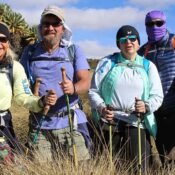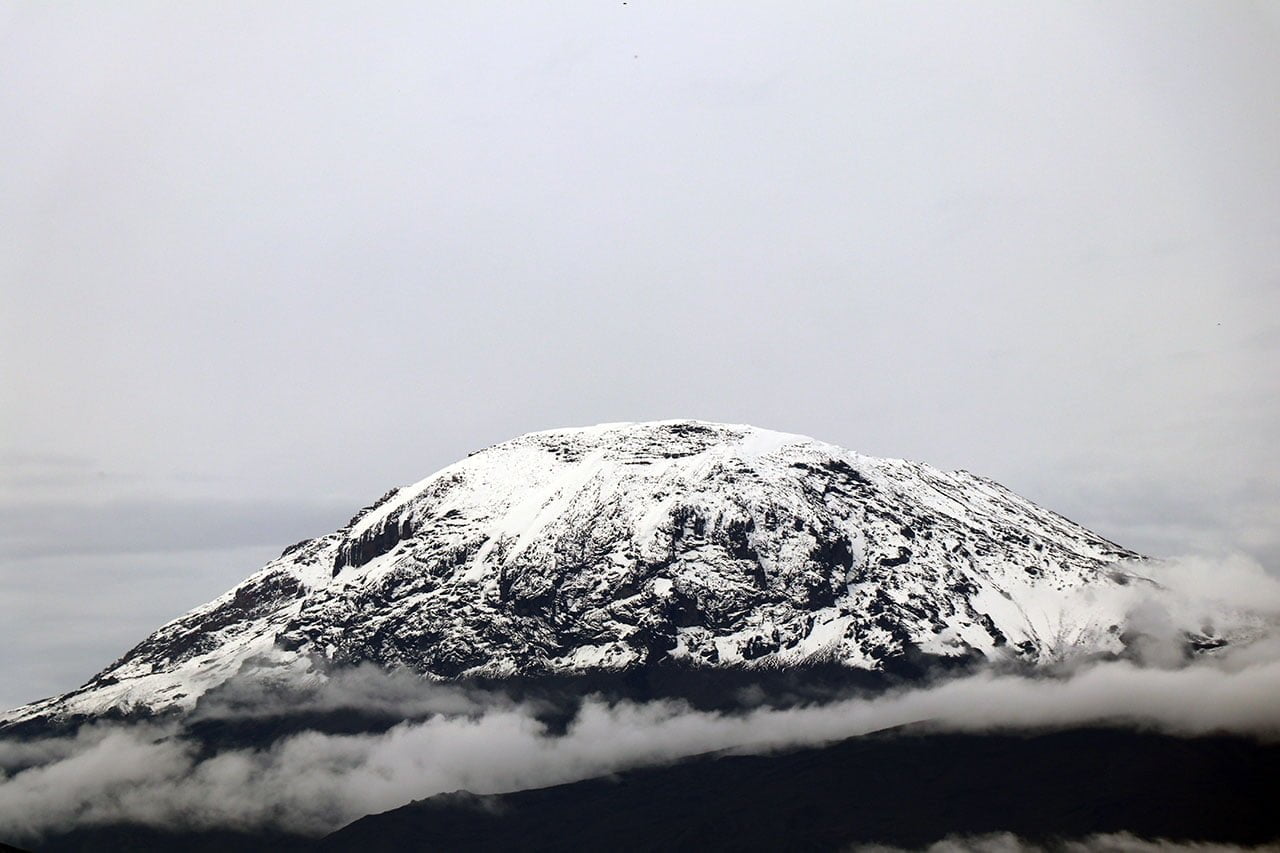
10 Highest Mountains in Africa
Highest Mountains in Africa
Mount Kilimanjaro is the highest mountain in Africa, consisting of three volcanic cones: Shira, Kibo, and Mawenzi. Located in Tanzania, it is a dormant volcano with a height of 5,895 meters or 19,341 feet above sea level. Here is a list of other tall mountains in Africa.
When you think of Africa’s geography, the blistering Sahara desert and the undulating grasslands and savannas of the Serengeti come to mind. As it turns out, the African continent is home to some of the most breathtaking mountains in the world, rivaling the Swiss Alps in beauty, the gorgeous Rocky Mountains in terms of craggy, snow-capped peaks, and even Mt. Everest in terms of climbing renown.
While some of the mountains in our top ten list result from plate tectonics, many are volcanic. Some may be climbed with perseverance and a day’s supplies, while others require specialised equipment and prior climbing expertise.
A handful are in devastated, war-torn places where political unrest affects daily existence. Each has an interesting tale to share.
Before we begin, there is some valid misunderstanding around using certain terms. The term “mountain” appears to be used interchangeably with the phrases “peak” and “summit.”
However, for the sake of geological accuracy, these terms are distinct, and each has a specific meaning:
- Mountain – A geological or geographical feature that rises 1,000 feet (300 meters) over its immediate surroundings.
- Peak – A point on a mountain that is higher than the surrounding points. A mountain will typically have several, if not many, summits.
- Summit – The highest peak of a mountain. Every summit is a peak, but not all peaks are summits.
There are several ways to list mountains by elevation. Many rankings are based on pure altitude, regardless of whether a mountain is genuinely a mountain or just a designated peak. The following list ranks genuine mountains based on their minimum prominence (distance from the peak to the lowest immediately surrounding terrain) of 1,300 feet (approximately 400 meters).
#1. Mount Kilimanjaro, Tanzania
Kibo peak, 5,895 meters
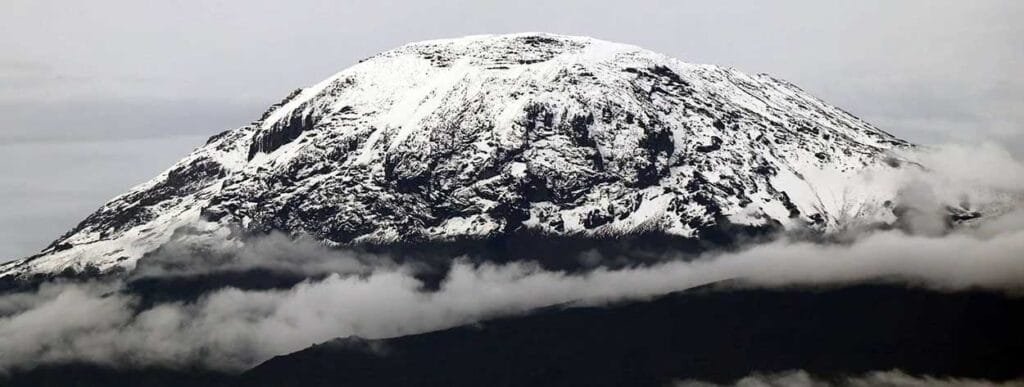
- Name: Kilimanjaro
- Elevation: 19,341 feet (5,895 meters)
- Mountain Range: Kilimanjaro Mountain Range
- Country: Tanzania
- Difficulty of Ascent: Rated as Walk-Up
Mount Kilimanjaro is Africa’s tallest peak, as well as its most famous and iconic, serving as the face of numerous African tourism brochures and campaigns, and with good reason. Mount Kilimanjaro is a breathtaking sight that rises over the lowlands and grasslands of northeast Tanzania. It is one of the world’s tallest freestanding mountains, dominating the Tanzanian landscape for kilometers and miles.
Mount Kilimanjaro’s top is made up of three principal peaks, all volcanoes: Kibo (dormant), Mawenzi (dormant), and Shira (extinct). Kilimanjaro, as the mountain is popularly known among Tanzanians, is Africa’s representation in the Seven Summits, which are the highest peaks on each of the seven continents.
Kilimanjaro, at 19,341 feet, is more than 2,000 feet higher than Mount Kenya. It is also extraordinarily large in terms of sheer size, reaching over 25 miles wide and covering nearly 500 square miles at its base. Mount Kilimanjaro has five climatic zones, from base to summit: rainforest, heath land, moorland, alpine desert, and arctic.
Climbing Notes
Every year, tens of thousands of explorers and tourists flock to Kilimanjaro, hoping to reach the peak. Because of its tremendous popularity, the mountain’s trail system is well built, with six primary routes beginning at the base and ascending to a circular path composed of two loops. Smaller trails branch off these circuits and are utilised to complete the climb to the peak.
The journey from the base to the circular route is not technically difficult (no special climbing equipment is necessary), but it is physically strenuous. Aside from its stunning beauty, this is one of the reasons Kilimanjaro is so well-known: its top is more accessible than adjacent summits like Mount Kenya, which need climbing expertise and specific equipment such as crampons and anchors.
While many people reach the circular route under the summit zone, only a handful make it to Mount Kilimanjaro’s summit, which is more than three and a half miles above sea level. Acclimatization to altitude is the key hurdle (only 10% of summit efforts are successful), and altitude sickness can develop at heights exceeding 4,000 feet.
#2. Mount Kenya, Kenya
Bastian peak, 5,199 metres
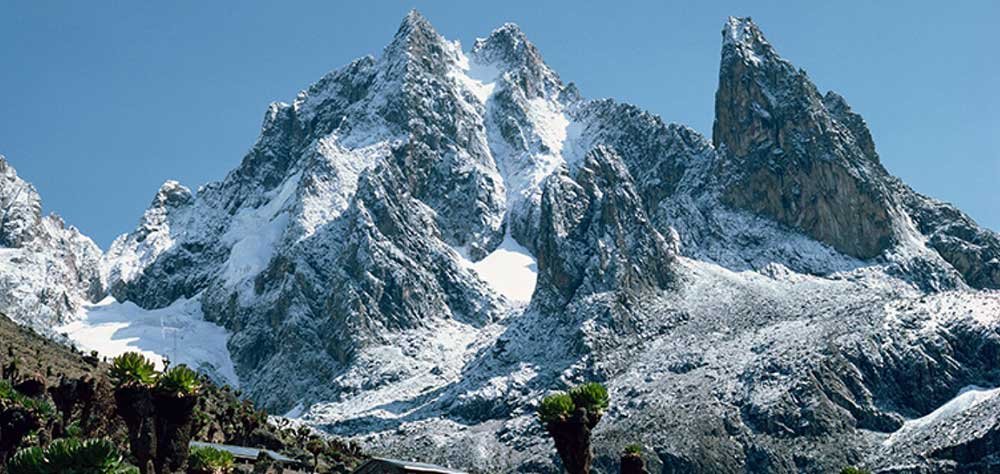
- Name: Kenya
- Elevation: 17,047 feet (5,196 meters)
- Mountain Range: Mount Kenya Mountain Range
- Country: Kenya
- Difficulty of Ascent: Rated as Technical Climb
As our selection narrows down to two, we wave farewell to Uganda, the Democratic Republic of the Congo, and the spectacular Rwenzori mountains before crossing into Kenya to face Mount Kenya. The second tallest peak in Africa is an extinct volcano. It features two main summits, Batian and Nelion, which are usually snow-capped.
Although it is located near the equator, Mount Kenya receives a significant quantity of snowfall each year. In fact, unlike most other mountains of its size in Africa, Mount Kenya plays an extremely important role in the region’s environment. It delivers fresh water to roughly seven million Kenyans. Although the majority of this comes from regular rainfall and snowmelt, there is fear that the once-mighty glaciers and ice banks could soon disappear.
Mount Kenya is also home to a diverse range of wildlife, woods, and plants, and it has been designated as an African World Heritage Site to boost conservation efforts in the region. Mount Kenya, like many other East African mountains, has varying height zones. Elephants, buffalo, lions, leopards, antelope, and other species live in the sub-alpine zone, which is characterized by lush woods, huge meadows, and open plains.
Climbing Notes
The second tallest peak in Africa. Mount Kenya is a renowned location for climbers and mountaineers. It is often regarded as a more difficult hike than the peak at number one on our list. It is possibly the most technical ascent in East Africa if not the whole continent. Climbers and mountaineers can take particular routes to the top that involve rock, snow, and ice climbing abilities.
Unfortunately, global warming and climate change are swiftly altering the terrain of many of the world’s mountains, with Mount Kenya no exception. Massive glaciers and permanent ice formations, which formerly provided world-class ice climbing possibilities, are progressively receding. Estimates vary on timing, but it might take another ice age to replace glacial ice on African mountaintops.
#3. Mount Stanley, Uganda and Democratic Republic of Congo
Margherita peak, 5,109 meters
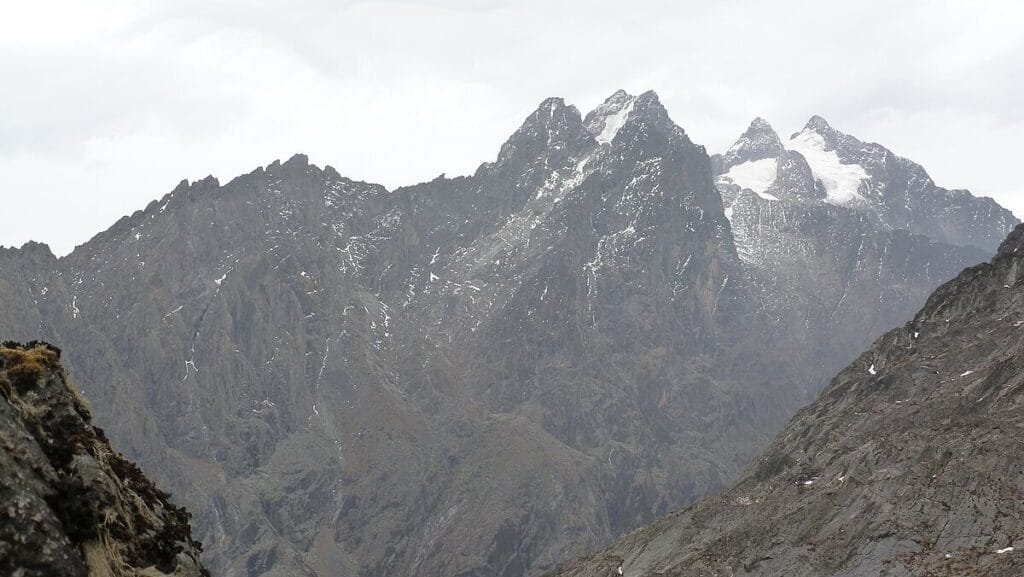
- Name: Stanley
- Elevation: 16,794 feet (5,119 meters)
- Mountain Range: Rwenzori Mountain Range
- Country: Democratic Republic of Congo and Uganda
- Difficulty of Ascent: Rated as Scramble
Mount Stanley is the mightiest of the Rwenzoris and ranks third on our list of Africa’s tallest mountains. Together with Mount Speke (number four) and Mount Baker (number five), these three mountains form a towering triangle that encloses the Bujuku Valley below. The top is highlighted by two prominent twin summits, Margherita and Alexandra, and other lesser peaks.
Glaciers altered the entire region millennia ago. The Bujuku Valley is presently located where a large glacier previously existed. The six highest summits in the Rwenzori range were formerly capped by glaciers, but only the three highest have visible glacial ice, and Mount Stanley is the only one of significance. Some estimates predict that by 2025, all Rwenzori glaciers will have melted.
The constant mist that shrouds practically all of the Rwenzori mountains, particularly Mount Stanley, contributes to the serene atmosphere that pervades the whole region, from valleys to summits. Mount Stanley would undoubtedly have more popularity, notoriety, and visitors if it weren’t for the two notable mountains that come in second and first place on this list.
Climbing Notes
Mount Stanley, with the only fully glaciated top among the Rwenzori mountains, provides unique obstacles to anyone attempting to climb to its highest summits. Climbing rope is necessary, and proper ice climbing gear is suggested, owing to the possibility of enormous crevasses in the ice that must be spanned.
According to some stories, travelling to the mountain from either Uganda or the Democratic Republic of the Congo is difficult, frequently taking days of trudging through dense forests and marshes. Trails are well-marked at the mountain’s base, and huts and shelters are found at various elevations across the range.
#4. Mount Speke, Uganda
Mount Speke, 4,890 meters
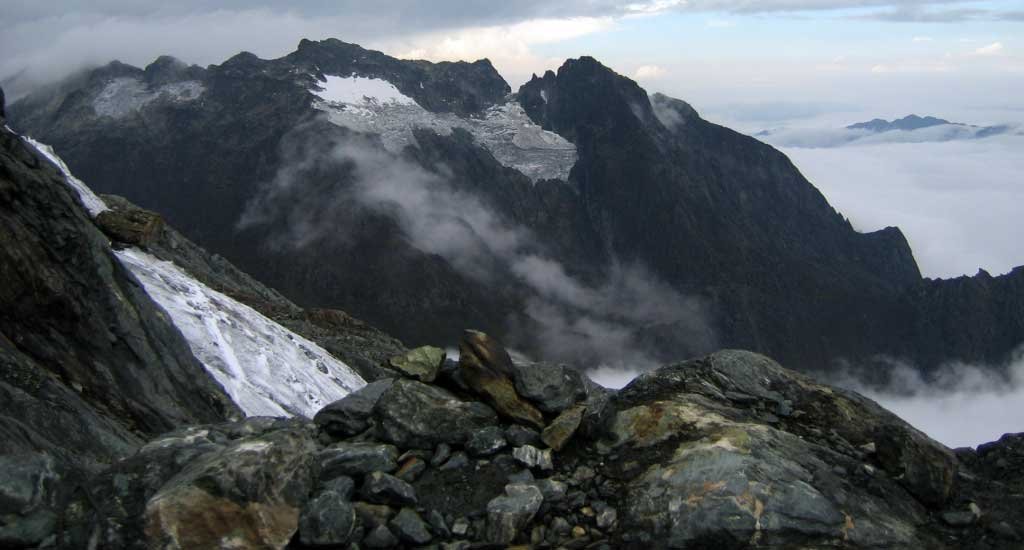
- Name: Speke
- Elevation: 16,043 feet (4,890 meters)
- Mountain Range: Rwenzori Mountain Range
- Country: Uganda
- Difficulty of Ascent: Rated as Scramble
The Rwenzori mountain range’s second-highest peak is Africa’s fourth-highest. Mount Speke’s summit consists of four peaks: Vittorio Emanuele, Ensonga, Johnston, and Trident. Trekking between peaks is perilous since they are linked by razor-thin slopes and steep valleys with precipitous sides. To say you’ve climbed to the top of Mount Speke puts you in excellent company.
Mount Speke poses unique challenges to climbers since it has the same components that support the delicate yet robust ecosystems at lower elevations. The Rwenzori mountain range is located in the equatorial belt that surrounds the globe. As a result, it is susceptible to seasonal monsoon rains, which provide life-giving water to flora and fauna while making climbing conditions sticky, slippery, and dangerous.
Unfortunately, political instability in the Democratic Republic of the Congo and, on occasion, Uganda has led explorers to reconsider their plans. Climbers have reported climbing up the slopes of Mount Speke, escorted by a guard armed with an AK-47. The conventional rationale is that the bodyguards are there to protect against wildlife, but the animals are not the focus.
Climbing Notes
Mount Speke used to need heavy snow and ice climbing gear to reach its summit, but that obstacle is no longer there because there are few significant ice patches. The general terrain is rather rugged, with sections needing your complete concentration. Overall, technical needs are minor, and as one source puts it, one could do the entire ascent “in tennis shoes…if the mud isn’t too bad.
#5. Mount Baker, Uganda
Mount Baker, 4,844 meters
- Name: Baker
- Elevation: 15,892 feet (4,844 meters)
- Mountain Range: Rwenzori Mountain Range
- Country: Uganda
- Difficulty of Ascent: Rated as Basic Snow/Ice Climb
Mt Baker moves us into the top five, but Mount Emin is only a short distance away at number six. The Rwenzori mountain range includes three of Africa’s top five tallest mountains. Legend has it that Ptolemy, during his quest for the Nile’s source, was so captivated by the sight of these mountains that he named them the “Mountains of the Moon.”
The whole Rwenzori mountain range, including Mount Ras Dejen (number nine on our list), is an officially declared African World Heritage Site. As is common in many of Africa’s larger mountains, the ecosystems on the steep slopes beneath the alpine tree line support immensely diverse flora and fauna, many of which are uncommon and, tragically, endangered.
Climbing Notes
Mount Baker’s harsh and jagged geological characteristics are similar to those of the other Rwenzoris, since the entire range is made up of fault-block mountains caused by fractures in the earth’s plates thrusting enormous pieces of crust and rock upward or downward. This is one of the most popular Rwenzori mountains for climbers, with various paths running beside magnificent alpine lakes.
Depending on the route selected, narrow ridge lines and deep crevasses can provide substantial problems to climbers attempting to reach the top, and some ice formations persist on the highest summits.
#6. Mount Emin, Democratic Republic of Congo
Mount Emin, 4,798 meters
- Name: Emin
- Elevation: 15,741 feet (4,798 meters)
- Mountain Range: Rwenzori Mountain Range
- Country: Democratic Republic of Congo
- Difficulty of Ascent: Rated as Technical Climb
Mt Emin, Africa’s sixth tallest peak, is located in the Rwenzori range, sister to Mount Gessi. The mountain is situated on the Democratic Republic of Congo side of a deep, narrow valley, named after explorer Mohammed Amin Asha, who explored the continent in the late 1800s.
Italian adventurer Prince Luigi Amedeo, Duke of Abruzzi, climbed Mount Emin in Africa, marking the first reported ascent. The Rwenzori range named Mount Luigi di Savoia after him, honoring his achievements in Africa.
Climbing Notes
Mount Emin, the northernmost peak in the Ruwenzori range, presents a formidable challenge due to its narrow ridges, high rock walls, and jagged formations. To safeguard the lead climber, climbers should bring class 5 climbing gear, rope, crampons, and protection equipment.
Like Mount Gessi, the glaciers that originally covered the heights have vanished, although patches of ice (and hence crevasses) remain.
#7. Mount Gessi, Uganda
Mount Gessi, 4,715 meters
- Name: Gessi
- Elevation: 15,469 feet (4,715 meters)
- Mountain Range: Rwenzori Mountain Range
- Country: Uganda
- Difficulty of Ascent: Rated as Scramble
The Democratic Republic of the Congo and Uganda share borders with the Rwenzori Mountains National Park, home to five of Africa’s ten tallest mountains, including Mount Gessi, named after Italian explorer Romulo Gessi, who discovered the Nile River source.
Mount Gessi, like many of the other African mountains on our list, alternates between lush, green ecosystems teeming with animals and plants at lower levels and jagged, volcanic forms at higher elevations.
This mountain, along with other summits in the Rwenzori range, once had prominent glacial ice at their peaks, which are now rapidly succumbing to the effects of global warming and climate change.
Established trails and the availability of guides from local tribes make this trek a reasonably straightforward affair to plan and book. The Democratic Republic of Congo offers hospitable overnight stays on the mountain, with huts and cabins available for access from both Ugandan and Congon sides.
Climbing Notes
The wet climate in the Rwenzori range leads to slick pathways and rock surfaces covered with slippery moss. Although no specialized gear is needed, climbing rope is essential for more popular trails. As elevation increases, the journey becomes rockier with jagged formations and steep slabs of rock.
#8. Mount Meru, Tanzania
Socialist peak, 4,562 meters
- Name: Mount Meru
- Elevation: 14,980 feet (4,566 meters)
- Mountain Range: Meru Mountain Range
- Country: Tanzania
- Difficulty of Ascent: Rated as Walk-Up
Mount Meru is a spectacular destination in its own right, popular with mountain climbers looking to acclimate their bodies to the rigours of ascending its more famous cousin. It is located in Arusha National Park, in northern Tanzania. Mount Meru is a volcano (opinions differ on whether it is active or dormant), and the last significant eruption occurred 8,000 years ago.
Mount Meru is located in one of Tanzania’s national parks, so visitors can get a close look at the area’s wildlife, which includes buffalo, giraffes, and elephants. The threat that these creatures represent to hikers is so significant that armed rangers accompany tourists as they ascend Mount Meru’s slopes.
Mount Meru provides tourists with significant variations in ecosystems and geological characteristics. Mount Meru, located in the bottom half of the volcanic mountains, offers a breathtaking view of the crater, rewarded by its lush rainforests and jagged, stony characteristics, reaching up to 9,500 feet/2,900 meters.
Climbing Notes
According to all estimates, Mount Meru is as beautiful and magnificent as “that other mountain” in Tanzania. However, because it is less popular with visitors, it is far less congested, making it an ideal location for climbers.
Tanzanian fauna, especially African animals, are a sight to see in the gorgeous Tanzanian terrain, and the ride provides breathtaking views of these majestic creatures, adding to the whole experience.
#9. Mount Semien, Ethiopia
Ras Dashen peak, 4,550 meters
- Name: Ras Dejen (also Ras Dashen)
- Elevation: 14,872 feet (4,533 meters)
- Mountain Range: Simien Mountain Range
- Country: Ethiopia
- Difficulty of Ascent: Rated as Scramble
Mount Ras Dejen is the ninth tallest peak in Africa and the highest point in Ethiopia, which is located on the continent’s eastern edge. It is located in northern Ethiopia’s Simien mountain range and is one of the park’s primary attractions.
Mount Ras Dejen is renowned for its steep rock cliffs and craggy summits, which visually contrast with the vast valleys surrounding it.
This region, formed by volcanic activity between 20 and 30 million years ago, is well-known for its incredible biodiversity. However, the endangered state of some of its species and plants helped to earn it recognition as an African World Heritage Site by the United Nations Educational, Scientific, and Cultural Organisation (UNESCO) in 1978.
The Walia ibex, a rare species located in the Simien Mountains, has made a comeback thanks to a collaborative conservation effort that began with the park’s classification as a World Heritage Site.
Climbing Notes
The ideal destination for those seeking technical skills, Ethiopia offers a stunning panoramic view and a half-day scrambling journey from base to summit, requiring good health and fitness, offering a well-rested reward.
#10. Mount Karisimbi, Democratic Republic of Congo and Rwanda
Mount Karisimbi, 4,507 meters
- Name: Karisimbi
- Elevation: 14,786 feet (4,507 meters)
- Mountain Range: Virunga Mountain Range
- Country: Democratic Republic of Congo/Rwanda
- Difficulty of Ascent: Rated as Scramble
Mt Karisimbi, located in the Virunga mountain range that extends along the boundary between the Democratic Republic of Congo and Rwanda, ranks as Africa’s tenth tallest.
The Virunga Mountains, with Mount Karisimbi as the highest stratovolcano, are home to eight volcanoes, many of which still contain craters at their summits.
Mount Karisimbi is located in Volcanoes National Park, which is well-known for its mountain gorillas and rich alpine forests.
Dian Fossey, an American mountain gorilla environmentalist and scientist, established the Karisoke Research Center in this area in 1967, and half a century later, the Dian Fossey Gorilla Fund continues her incredible work.
Regardless of the abundance of natural beauty, a porter is essential in areas with indigenous fauna and potential hazards from violence or political unrest.
Climbing Notes
Gorilla trekking trips up Mount Karisimbi often involve gorilla watching activities, starting at the mountain’s base and ending with overnight camps at intermediate elevations. The journey typically takes two to three days, starting with an early dawn start in deep forests and continuing to the peak on day three.
Although it significantly increases the expense of the vacation, a gorilla hike may be a once-in-a-lifetime opportunity to view a mountain gorilla up close. Gorillas seen in zoos are lowland gorillas, a distinct species.
Before You Pack Those Bags
If there is one common thread running across the ten mountains on our list, it is the significance of properly researching your African mountain trip and scheduling your itinerary with a trustworthy agency, whether in the United States or Africa. The vast majority of the mountains on this list require climbers to be accompanied by guides or porters. With appropriate planning, the experience of a lifetime awaits.



